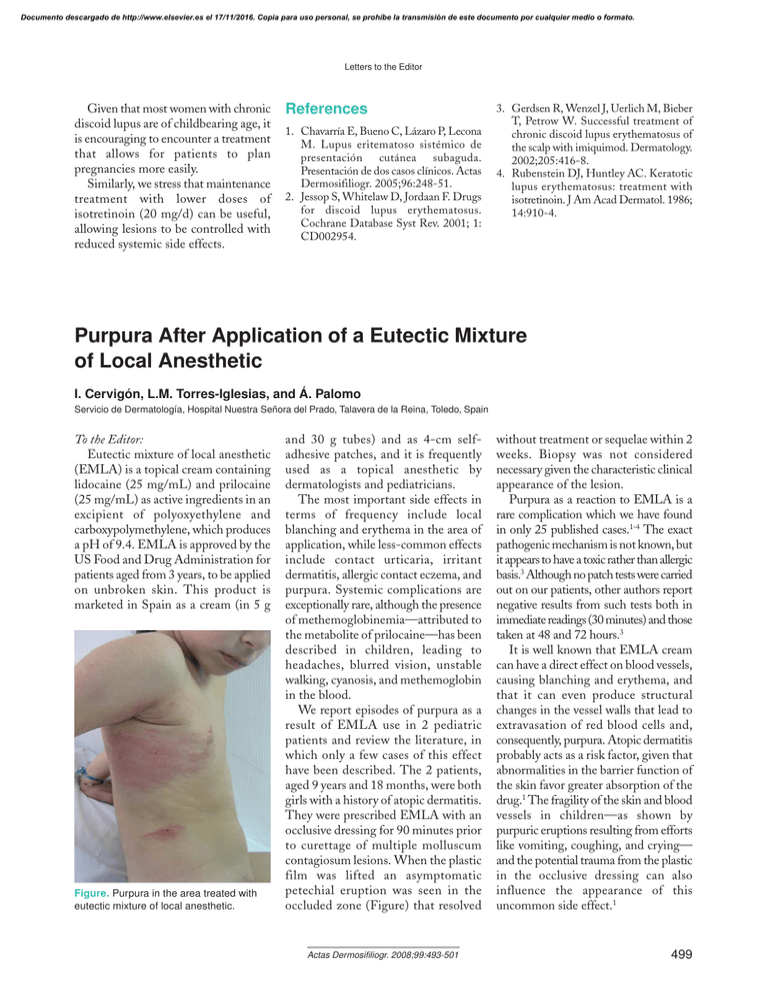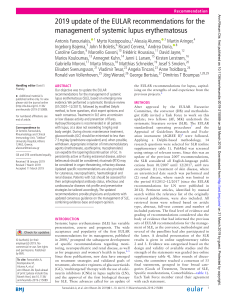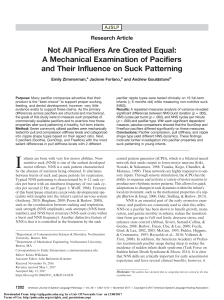Purpura After Application of a Eutectic Mixture of Local
Anuncio

Documento descargado de http://www.elsevier.es el 17/11/2016. Copia para uso personal, se prohíbe la transmisión de este documento por cualquier medio o formato. Letters to the Editor Given that most women with chronic discoid lupus are of childbearing age, it is encouraging to encounter a treatment that allows for patients to plan pregnancies more easily. Similarly, we stress that maintenance treatment with lower doses of isotretinoin (20 mg/d) can be useful, allowing lesions to be controlled with reduced systemic side effects. References 1. Chavarría E, Bueno C, Lázaro P, Lecona M. Lupus eritematoso sistémico de presentación cutánea subaguda. Presentación de dos casos clínicos. Actas Dermosifiliogr. 2005;96:248-51. 2. Jessop S, Whitelaw D, Jordaan F. Drugs for discoid lupus erythematosus. Cochrane Database Syst Rev. 2001; 1: CD002954. 3. Gerdsen R, Wenzel J, Uerlich M, Bieber T, Petrow W. Successful treatment of chronic discoid lupus erythematosus of the scalp with imiquimod. Dermatology. 2002;205:416-8. 4. Rubenstein DJ, Huntley AC. Keratotic lupus erythematosus: treatment with isotretinoin. J Am Acad Dermatol. 1986; 14:910-4. Purpura After Application of a Eutectic Mixture of Local Anesthetic I. Cervigón, L.M. Torres-Iglesias, and Á. Palomo Servicio de Dermatología, Hospital Nuestra Señora del Prado, Talavera de la Reina, Toledo, Spain To the Editor: Eutectic mixture of local anesthetic (EMLA) is a topical cream containing lidocaine (25 mg/mL) and prilocaine (25 mg/mL) as active ingredients in an excipient of polyoxyethylene and carboxypolymethylene, which produces a pH of 9.4. EMLA is approved by the US Food and Drug Administration for patients aged from 3 years, to be applied on unbroken skin. This product is marketed in Spain as a cream (in 5 g Figure. Purpura in the area treated with eutectic mixture of local anesthetic. and 30 g tubes) and as 4-cm selfadhesive patches, and it is frequently used as a topical anesthetic by dermatologists and pediatricians. The most important side effects in terms of frequency include local blanching and erythema in the area of application, while less-common effects include contact urticaria, irritant dermatitis, allergic contact eczema, and purpura. Systemic complications are exceptionally rare, although the presence of methemoglobinemia—attributed to the metabolite of prilocaine—has been described in children, leading to headaches, blurred vision, unstable walking, cyanosis, and methemoglobin in the blood. We report episodes of purpura as a result of EMLA use in 2 pediatric patients and review the literature, in which only a few cases of this effect have been described. The 2 patients, aged 9 years and 18 months, were both girls with a history of atopic dermatitis. They were prescribed EMLA with an occlusive dressing for 90 minutes prior to curettage of multiple molluscum contagiosum lesions. When the plastic film was lifted an asymptomatic petechial eruption was seen in the occluded zone (Figure) that resolved Actas Dermosifiliogr. 2008;99:493-501 without treatment or sequelae within 2 weeks. Biopsy was not considered necessary given the characteristic clinical appearance of the lesion. Purpura as a reaction to EMLA is a rare complication which we have found in only 25 published cases.1-4 The exact pathogenic mechanism is not known, but it appears to have a toxic rather than allergic basis.3 Although no patch tests were carried out on our patients, other authors report negative results from such tests both in immediate readings (30 minutes) and those taken at 48 and 72 hours.3 It is well known that EMLA cream can have a direct effect on blood vessels, causing blanching and erythema, and that it can even produce structural changes in the vessel walls that lead to extravasation of red blood cells and, consequently, purpura. Atopic dermatitis probably acts as a risk factor, given that abnormalities in the barrier function of the skin favor greater absorption of the drug.1 The fragility of the skin and blood vessels in children—as shown by purpuric eruptions resulting from efforts like vomiting, coughing, and crying— and the potential trauma from the plastic in the occlusive dressing can also influence the appearance of this uncommon side effect.1 499 Documento descargado de http://www.elsevier.es el 17/11/2016. Copia para uso personal, se prohíbe la transmisión de este documento por cualquier medio o formato. Letters to the Editor References 1. Neri I, Savoia F, Guareschi E, Medri M, Patrizi A. Purpura after application of EMLA cream in two children. Pediatr Dermatol. 2005;22: 556-8. 2. 3. Calobrisi SD, Drolet BA, Esterly NB. Petechial eruption after the application of EMLA cream. Pediatrics. 1998;101: 471-3. De Waard-van der Spek FB, Oranje AP. Purpura caused by EMLA is of 4. toxic origen. Contact Dermatitis. 1997; 36:11-3. Gourrier E, El Hanache A, Karoubi P, Mouchnino G, Merbouche S, Leraillez J. Cutaneous problems after application of EMLA in premature infants. Arch Pediatr. 1996;3:289-90. Unilateral Nevoid Hyperkeratosis of the Nipple and Areola Treated With Topical Calcitriol E. Guevara-Gutiérrez,a V.M. Tarango-Martínez,a C. Sandoval-Tress,a and M. Hernández-Torresb a Departamento de Dermatología and bDepartamento de Dermatopatología, Instituto Dermatológico de Jalisco «Dr. José Barba Rubio» Secretaría de Salud Jalisco, Jalisco, Mexico To the Editor: Hyperkeratosis of the nipple and areola (HNA) is an uncommon condition characterized by verrucose thickening and café-au-lait pigmentation of the nipple and areola.1 It was first described by Tauber in 1923 and approximately 70 cases have been published to date in the medical literature. Several therapeutic approaches have been used to treat this condition, although no gold standard has yet been established. We report the case of a 35-year-old man with a 5-year history of mildly pruriginous dermatosis on the nipple and areola of the left breast. The dermatosis started as an erythematous area and progressed to form a hyperpigmented plaque with thickening of the skin during the 18 months before the visit. The patient applied topical fluocinolone acetonide for 2 years, with some initial improvement; however, shortly after the patient started the treatment, the dermatosis spread. Physical examination revealed a verrucose, hyperpigmented, hyperkeratotic, oval plaque measuring 3.8 cm in diameter and surrounded by a café-aulait macule measuring 15 cm in diameter (Figure 1). The remainder of the examination was unremarkable. The initial clinical diagnosis was seborrheic keratosis. A punch biopsy 500 was performed, and staining with hematoxylin-eosin revealed the presence of hyperkeratosis, acanthosis, and papillomatosis (Figure 2). Based on the combination of histopathology and clinical findings, a diagnosis of unilateral nevoid hyperkeratosis of the nipple and areola (NHNA) was made. Treatment was started with topical calcitriol, 0.3%. The ointment was applied twice per day for 6 months and the hyperkeratosis resolved completely, although it left residual hyperpigmentation of the skin. The patient showed no side effects after applying the medication. HNA has been classified in 3 groups: HNA that presents as an extension of an epidermal nevus; HNA associated with other dermatoses such as acanthosis nigricans, cutaneous T-cell lymphoma, Darier disease, chronic eczema, ichthyosis, and ichthyosiform erythroderma; and idiopathic HNA, also known as NHNA.1-6 NHNA is more common in female patients (80%) aged 10 to 30.1,2,4-7 To date, only 11 cases have been reported in men.2,3,6,8,9 The lesions are generally bilateral and affect the nipple and areola in 72% of cases and the nipple only in 28%.6 The cause is unknown, but several factors, mainly endocrine factors,6,7 seem to affect the development of this Actas Dermosifiliogr. 2008;99:493-501 Figure 1. Hyperkeratotic, hyperpigmented, and verrucose plaque on the nipple and areola of the left breast. Figure 2. Photomicrograph showing hyperkeratosis, acanthosis, and papillomatosis (hematoxylin-eosin, ×10). condition. Clinically, it is characterized by verrucose, hyperkeratotic, and hyperpigmented lesions on the areola




